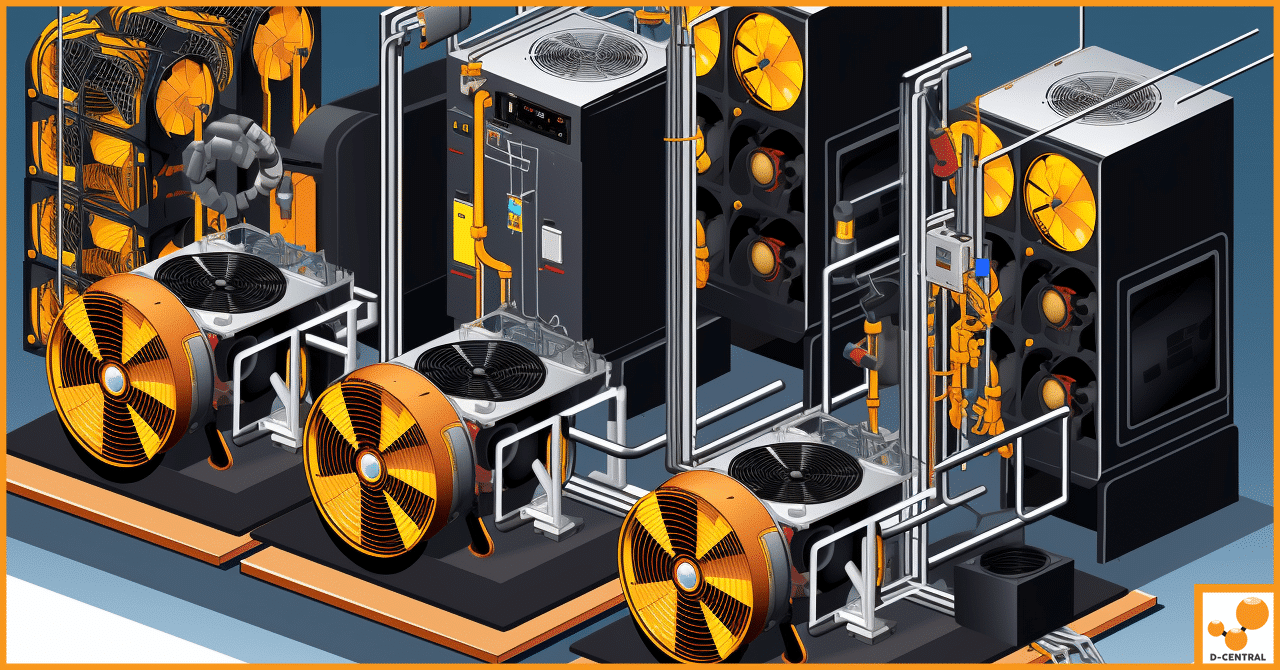
Bitcoin Mining Machine Repair: A Key to Consistent Mining Success
Bitcoin mining stands as a cornerstone of the cryptocurrency ecosystem, serving as the process by which new bitcoins are introduced
4479 Desserte Nord Autoroute 440, Laval, QC H7P 6E2

In the ever-evolving world of digital finance, Bitcoin emerges as a pioneering force, reshaping our understanding of money and transactions. Launched in 2009 by an enigmatic figure or group known as Satoshi Nakamoto, Bitcoin introduced the world to the concept of cryptocurrency – a decentralized digital currency that operates independently of traditional banking systems. Its revolutionary blockchain technology ensures security, transparency, and immutability of transactions, making it a trailblazer in the realm of digital currencies. As the first of its kind, Bitcoin has not only paved the way for numerous other cryptocurrencies but has also challenged conventional financial models, offering a peer-to-peer electronic cash system that transcends geographical boundaries and central authority control.
At the heart of Bitcoin’s functionality and security lies a critical process known as Bitcoin mining. Far from the imagery of physical mining, this digital process involves the use of sophisticated computers and software to validate and record transactions on the Bitcoin blockchain. Mining serves a dual purpose: it is the method through which new Bitcoins are created and introduced into circulation, and it is also essential for maintaining the ledger of transactions in a decentralized manner. This process is fundamental to the Bitcoin network as it ensures the integrity and chronological order of transactions, preventing issues such as double-spending.
This article aims to delve into the intricacies of Bitcoin mining, a cornerstone of the Bitcoin network that remains shrouded in complexity and technicality. We will explore the processes involved in mining, the technologies employed, and the significant impact this critical function has on the broader cryptocurrency ecosystem. From the computational power required to the economic and environmental considerations, Bitcoin mining is a multifaceted operation that plays a pivotal role in the sustenance and growth of Bitcoin as a leading digital currency. As we navigate through the nuances of this process, we gain a deeper understanding of not just how Bitcoin functions, but also how it continues to influence the landscape of digital currencies and the global financial system at large.
Bitcoin mining is a critical process in the network of Bitcoin, the world’s first decentralized digital currency. At its core, mining involves the use of powerful computers to solve complex mathematical problems. These problems are part of the cryptographic framework that underpins the blockchain, the digital ledger that records all Bitcoin transactions. When miners successfully solve these problems, they are allowed to add a new block of transactions to the blockchain. In return for their efforts and the computing power expended, miners are rewarded with newly minted bitcoins. This process not only introduces new bitcoins into the system in a controlled and predictable manner but also secures and verifies the transactions that make up the Bitcoin network.
The history of Bitcoin mining is a tale of innovation and adaptation. In the early days of Bitcoin, mining was relatively simple and could be performed on regular desktop computers. Miners were able to solve the cryptographic puzzles using CPUs (Central Processing Units). However, as Bitcoin grew in popularity, so did the difficulty of mining. This led to the use of GPUs (Graphics Processing Units), which were more efficient for mining purposes. The continuous increase in mining difficulty necessitated even more powerful hardware, leading to the development of ASICs (Application-Specific Integrated Circuits) designed solely for Bitcoin mining. These technological advancements have made mining more efficient but also more resource-intensive, leading to the creation of large mining pools where miners combine their computational power to compete more effectively.
Mining plays a vital role in maintaining the security and integrity of the Bitcoin network. Each block of transactions added to the blockchain by miners is verified and secured through a consensus mechanism known as Proof of Work (PoW). This mechanism requires miners to prove that they have expended a significant amount of computational effort (work) to solve the cryptographic puzzles. This process not only prevents fraudulent transactions but also protects the network from double-spending and various forms of attack. By validating and securing transactions, miners uphold the decentralized nature of the Bitcoin network, ensuring that no single entity has control over the transaction ledger. This decentralized verification process is fundamental to the trust and security that underpin Bitcoin, making mining an indispensable component of the cryptocurrency’s infrastructure.
Bitcoin mining is a complex and multifaceted process that forms the backbone of the Bitcoin network. It involves several key steps:
The Proof-of-Work (PoW) consensus mechanism is central to the mining process. It requires miners to prove that they have expended computational effort to solve the cryptographic puzzle. This mechanism serves two purposes:
The technical process of Bitcoin mining is not only a testament to the ingenuity of blockchain technology but also a critical component in maintaining the security, integrity, and decentralized nature of the Bitcoin network.
The evolution of Bitcoin mining has seen a progression in the hardware used, from basic CPUs to more advanced GPUs and ASICs, each offering different levels of efficiency and power.
Mining software connects your hardware to the Bitcoin network and enables you to perform mining operations. It plays a crucial role in delivering the work to miners, collecting the completed work, and adding the information back to the blockchain. Popular examples include:
Mining pools are groups of miners who combine their computational power to increase their chances of successfully mining a block. The rewards are then distributed among pool members based on the amount of work each miner contributed. This collaboration makes mining more accessible and profitable for individual miners, especially those with less powerful hardware.
The choice of mining hardware and software, along with the decision to join a mining pool, significantly impacts the efficiency, cost, and overall success of a Bitcoin mining operation. These elements are crucial in navigating the competitive landscape of Bitcoin mining.
Bitcoin mining is a resource-intensive activity, and understanding its economics requires a thorough analysis of the associated costs:
Several key factors influence the profitability of Bitcoin mining:
Bitcoin halving is an event that occurs approximately every four years, where the reward for mining a new block is halved. This mechanism:
Bitcoin mining is not evenly distributed globally, with certain regions dominating due to favourable conditions:
The economics of Bitcoin mining are complex and influenced by a variety of factors, including operational costs, market conditions, and global distribution. Understanding these dynamics is crucial for anyone considering entering the mining space.
Getting started with Bitcoin mining requires careful planning, a clear understanding of the investment involved, and ongoing management of both operational and market risks. For beginners, joining a mining pool can be a more feasible way to start, offering a balance between investment and potential rewards.
In this comprehensive exploration of Bitcoin mining, we’ve delved into various facets of this crucial process that powers the Bitcoin network. We began by defining Bitcoin mining and its historical evolution, from the use of simple CPUs to the advanced ASICs of today. The technical process of mining was unpacked, highlighting the intricate steps involved in transaction verification, solving cryptographic puzzles, and adding new blocks to the blockchain. We explored the different types of mining hardware and software, and the strategic decision-making involved in choosing between solo mining and joining a mining pool.
The economic aspects of Bitcoin mining were examined, including the significant costs involved, factors influencing mining profitability, and the impact of Bitcoin halving events. We also discussed the global distribution of mining activities and their broader economic implications. For those interested in starting their mining journey, we provided a step-by-step guide, considerations for hardware and software selection, and insights into risk assessment and management.
Bitcoin mining is more than just the process of generating new bitcoins. It is the heartbeat of the Bitcoin network, ensuring security, integrity, and decentralization. Through mining, transactions are verified, and the blockchain is maintained, making it a pivotal component in the functioning of the entire Bitcoin ecosystem.
Looking ahead, Bitcoin mining is poised to continue evolving. Technological advancements, increasing global interest in cryptocurrencies, and the ongoing dialogue around energy consumption and sustainability are likely to shape the future of mining. As the industry matures, we may see more innovations, regulatory developments, and perhaps a greater shift towards renewable energy sources in mining operations.
What is Bitcoin mining?
Bitcoin mining is the process of using powerful computers to validate and record transactions on the Bitcoin blockchain. Miners solve complex mathematical problems, and when successful, they can add a new block of transactions to the blockchain, earning newly minted bitcoins as a reward.
How has Bitcoin mining evolved?
Bitcoin mining has evolved from using simple CPUs to more advanced GPUs and custom-designed ASICs. Early mining could be done on regular desktop computers, but the increasing difficulty of mining led to the necessity for more efficient hardware.
What is the Proof of Work (PoW) consensus mechanism?
Proof of Work (PoW) is a consensus mechanism that requires miners to prove they have expended significant computational effort to solve cryptographic puzzles. This serves both to secure the network from fraudulent transactions and to maintain decentralization.
How does Bitcoin mining maintain the blockchain?
Bitcoin miners add blocks to the blockchain by verifying and securing transactions through solving cryptographic puzzles. Once a block is added, it becomes a permanent part of the public ledger of all Bitcoin transactions.
What are the capabilities of different mining hardware?
ASICs are custom-built for mining and are the most efficient, GPUs are versatile and moderately efficient, and CPUs are least efficient but inexpensive for those just starting out or experimenting.
What factors influence the profitability of Bitcoin mining?
Factors that influence the profitability of Bitcoin mining include the market price of Bitcoin, mining difficulty, miner’s hash rate, electricity costs, and the impact of Bitcoin halving events.
What is a Bitcoin halving event?
A Bitcoin halving event is when the reward for mining a new block is halved, which happens approximately every four years. It controls inflation and influences miners’ profitability.
What are the economic considerations for Bitcoin mining?
Economic considerations for Bitcoin mining include the initial hardware investment, ongoing electricity costs, operational expenses, and the impact of Bitcoin’s market value and mining difficulties on profitability.
How do mining pools work, and what are their advantages?
Mining pools are groups of miners that combine their computational power to increase the chances of mining a block. The rewards are distributed based on the work contributed. Pools offer more consistent rewards and a community for miners, especially those with less powerful hardware.
What are the risks associated with Bitcoin mining?
Risks include market volatility of Bitcoin’s price, high operational costs, regulatory changes, technology becoming obsolete, and security concerns surrounding mining setups and Bitcoin wallets.
DISCLAIMER: D-Central Technologies and its associated content, including this blog, do not serve as financial advisors or official investment advisors. The insights and opinions shared here or by any guests featured in our content are provided purely for informational and educational purposes. Such communications should not be interpreted as financial, investment, legal, tax, or any form of specific advice. We are committed to advancing the knowledge and understanding of Bitcoin and its potential impact on society. However, we urge our community to proceed with caution and informed judgment in all related endeavors.
Related Posts

Bitcoin mining stands as a cornerstone of the cryptocurrency ecosystem, serving as the process by which new bitcoins are introduced

In the dynamic world of cryptocurrency mining, Application-Specific Integrated Circuit (ASIC) miners have emerged as pivotal tools in the quest

In any mining setup, the crux of your success lies in the efficient functioning of your mining hardware. Acknowledging this